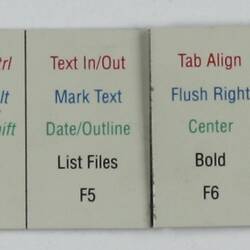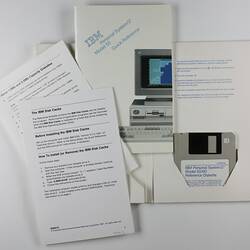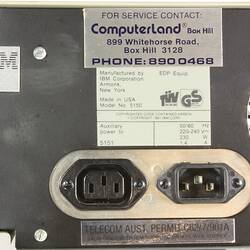Summary
This Computer model, PS/2., completes the set of early IBM computer models possessed by the Museum.
IBM set the standard for personal computing with its IBM PC series - the IBM PC, the IBM PC XT, the IBM PC AT and the PS/2 line. Each model represented major changes in processing, memory control and capacity, disk drives, operating systems and graphics. The IBM PC was announced in April 1981. By the end of 1983, the IBM PC had become the de facto standard for personal computing with a million machines approximately having been sold worldwide. Many manufacturers made low priced copies (clones) of the various models; a whole industry was created aping IBM machines, peripherals and software. The computer had become an ordinary commodity. The Museum possesses an IBM PC. The first upgrade was the IBM PC XT in response to the needs of business and professional customers. The Museum possesses an XT. The second upgrade was the IBM PC AT. This included major innovations in its development for example in terms of the processor, graphical capabilities and disk size. This particular machine was made in Australia.
Physical Description
Contents: single disk drive, monitor, keyboard, Quick reference manual (disk absent), set of 11 disks for PS/2 in disk box, Microsoft presentation boxes with 5.25 inch disks - Quick Pascal and Works, IBM OS/2 presentation box with 3.5 inch disks, Microsoft MS-Dos concise users guide, three X-Tree Pro Gold manuals - Startup, Word, Operations, mains cable missing. * Drive: Rectangular hard drive made of beige coloured plastic. Has operation switch and slot for inserting 3.5 floppy disks at front. There is an "Australian Made" logo sticker on the top with a yellow kangaroo on a green background inside a triangle on the top of the box. * Monitor: Beige coloured monitor with 11 inch screen. On swivel stand and has a black data cable attached at rear. * Keyboard: Beige coloured QWERTY keyboard with removable grey coil AMP cable at rear. On the bottom there are two feet for raising the keyboard. * Function key guide: Long, thin plastic strip split in the middle with coloured writing (black, red, blue, green) setting out the uses of the function keys on a computer keyboard. The card is laminated on the reverse. * Guide: Rectangular cardboard sleeve with colour photograph on outside of the PS/2 computer. Inside there is a 3.5" disk and a paper 54 page booklet. * Set of disks: Square plastic floppy disk (3.5 inch), four are made of black plastic and one is grey plastic. Various manufacturers. Inside blue plastic disk box with "Microsoft" logo.
More Information
-
Collecting Areas
-
Acquisition Information
Donation from Mr Martin Frysteen - Chisholm Institute, 16 Jul 2001
-
Manufacturer
-
Inscriptions
* Drive: On front: IBM/Personal System/2/Model 30 286 Type 8530-E31/S/N 90-A018680 On sticker on top: AUSTRALIAN MADE * Monitor: On front: IBM/Personal System/2/Color Display Type 8513-003/S/N 72-0124550 * Keyboard: On front: IBM * Function key guide: On front: WordPerfect/for IBM Personal Computers * Guide: On front of cardboard cover: IBM/Personal System/2/Model 50/Quick Reference/and/Reference Diskette On front of disk: IBM Personal System/2/Model 50/60/Reference Diskette On front of booklet: IBM/Personal System/2/Model 50/Quick Reference * Handwritten on disks in set: Disk 1: Martin [Illegible.] / DOS DISK #1/SDATA 1 Disk 2: WP51/3T93 files Disk 3: Windows No7. Disk 4: Dune 3
-
Brand Names
-
Classification
-
Category
-
Discipline
-
Type of item
-
References
Encyclopedia of Computer Science 4th Edition - Museum Victoria library
-
Keywords




